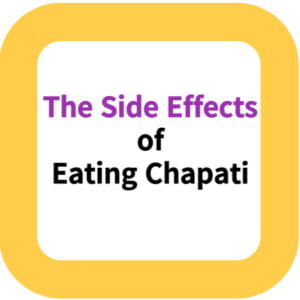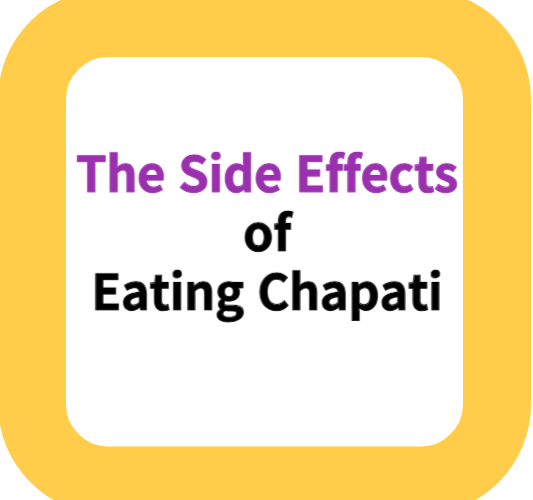The Side Effects of Eating Chapati
Welcome to our latest blog post where we delve into the intriguing world of chapati, a staple in many diets globally. Often hailed for its health benefits, chapati, a traditional Indian flatbread made from whole wheat flour, is a household name in culinary circles. However, like any food, it comes with its own set of considerations.
Our comprehensive article provides an in-depth analysis of the potential side effects associated with chapati consumption, balancing its nutritional benefits against possible health concerns. From understanding its basic composition to exploring issues related to gluten sensitivity, weight gain, blood sugar levels, and more, we offer insights for those looking to make informed dietary choices.
Whether you’re a chapati aficionado or just curious about incorporating it into your diet, join us as we unravel the complexities of this beloved food item, ensuring you can enjoy it in a way that best suits your health needs and lifestyle.
The Side Effects of Eating Chapati

Introduction: Understanding the Impact of Chapati on Health
In our detailed exploration, we delve into the side effects of consuming chapati, a staple food in many diets around the world. While chapati, made from whole wheat flour, is generally regarded as a nutritious and healthy option, it is crucial to understand how its consumption can impact different individuals under various dietary conditions.
This article aims to provide an in-depth analysis of these potential side effects, offering insights into both the benefits and drawbacks of including chapati in your diet.
Chapati: The Basics and Nutritional Overview
Chapati, commonly known as roti, is an integral part of many cuisines, particularly in South Asia and Africa. This simple, nutritious flatbread is made from a mixture of whole wheat flour, water, and a pinch of salt. Its popularity stems from its versatility, affordability, and the ease of preparation.
However, the health impact of chapati varies depending on individual dietary needs and consumption habits, making it essential to understand its nutritional profile and how it fits into a balanced diet.

Gluten Sensitivity: A Major Concern with Chapati
A significant health concern associated with chapati consumption is its gluten content. Being made from whole wheat flour, chapati contains gluten, a protein that can cause adverse reactions in individuals with gluten sensitivity or celiac disease.
Symptoms in such cases can range from mild digestive discomfort to severe health issues, highlighting the need for awareness and caution among those with gluten-related disorders.
Digestive Issues Linked to Chapati Consumption
The high fiber content of chapati is generally beneficial for digestive health, aiding in bowel regularity and overall gut function. However, excessive intake or consumption by individuals with sensitive digestive systems can lead to issues like bloating, gas, and abdominal discomfort. It’s important to consider individual digestive tolerance and adjust chapati intake accordingly to avoid such digestive issues.
The Risk of Weight Gain with Excessive Chapati Consumption
Chapati, being rich in carbohydrates, plays a crucial role in providing energy. However, overconsumption, especially when combined with high-calorie dishes, can lead to weight gain. This highlights the importance of portion control and the need to balance chapati intake with a diet rich in various nutrients to maintain a healthy weight and avoid obesity-related complications.
Blood Sugar Considerations for Chapati Eaters
For people with diabetes or those monitoring their blood sugar levels, chapati can be a double-edged sword. Its low glycemic index makes it a favorable choice, as it releases glucose into the bloodstream gradually.
However, it is still crucial for individuals with diabetes to watch their chapati intake and ensure it is balanced with their overall carbohydrate consumption to maintain stable blood sugar levels.
Nutrient Imbalance: A Potential Downside of Chapati
Chapati provides a good source of carbohydrates but may lack other essential nutrients. A diet heavily reliant on chapati without a diverse intake of other food groups can lead to nutritional deficiencies. To ensure a well-rounded diet, it is vital to incorporate a variety of food items, including fruits, vegetables, proteins, and healthy fats, along with chapati.
Allergic Reactions to Chapati Ingredients
Although rare, some individuals may experience allergic reactions to chapati due to its wheat content or the spices used in preparation. These reactions can range from mild symptoms like itching and hives to severe conditions like anaphylaxis. People who suspect an allergy to chapati or its ingredients should seek medical advice and consider alternative dietary options.
Iron Absorption Inhibition by Chapati
Chapati contains phytic acid, which can interfere with the body’s ability to absorb iron from other foods. This can be particularly concerning as iron deficiency can lead to anemia, characterized by symptoms like fatigue, weakness, and cognitive impairments. Pairing chapati with vitamin C-rich foods can enhance iron absorption and mitigate this issue.
Pesticide Residue Concerns in Chapati
Chapati made from conventionally grown wheat may contain traces of pesticides, raising concerns about long-term health effects. Choosing organic or locally sourced wheat flour can help minimize exposure to these potential harmful chemicals, contributing to a safer and healthier dietary choice.
Gastrointestinal Upset from Sudden Dietary Changes
A sudden increase in fiber intake, such as through increased consumption of chapati, can lead to gastrointestinal discomfort for some individuals. This may manifest as bloating, gas, and constipation, emphasizing the need for gradual dietary changes and mindful eating practices.
The Impact of Additives and Ingredients in Chapati
The way chapati is prepared can also influence its health impact. The use of additives or unhealthy fats in preparation can negate the health benefits of chapati, contributing to various health issues if consumed regularly. It’s important to be mindful of these factors when incorporating chapati into your diet.
Conclusion: Balancing Chapati Consumption for Optimal Health
In conclusion, while chapati is a nutritious and versatile component of a balanced diet, awareness of its potential side effects is essential. Issues such as weight gain, digestive problems, blood sugar fluctuations, and nutrient imbalances can arise from improper consumption.
Moderation, coupled with a diverse and balanced diet, is key to reaping the benefits of chapati while minimizing its drawbacks. For personalized dietary advice, consulting healthcare professionals is always recommended to cater to individual health needs and conditions.



